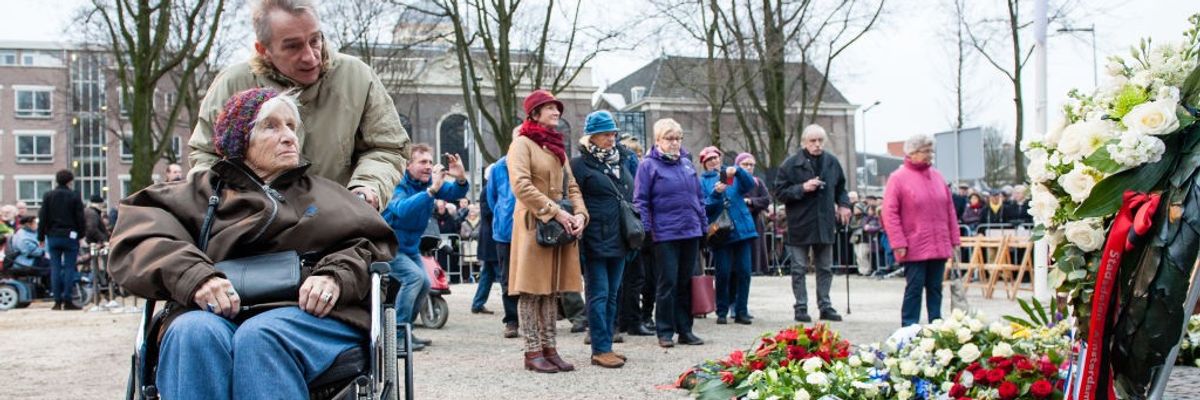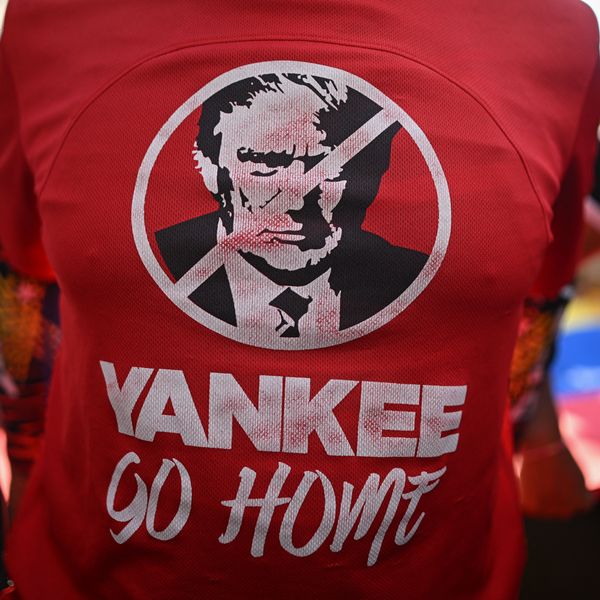
People take part at the commemoration of the February Strike of 1941 in Amsterdam, Netherlands, on 25 February 2017. The strike is remembered each year, where people lay flowers at the feet of statue depicting one of the dockworkers who led the day of action against the Nazi's rounding up of Jews in the Dutch city and beyond.
February Strike of 1941: When Citizens Took to the Streets Against the Nazis
Remembering how Amsterdam's working class stood up against Adolf Hitler's extermination of the Jews.
In three days, Amsterdam organized the only general strike in Europe to protest the first roundup of Jews. People poured into the streets on February 25, 1941—an estimated 300,000 of the 800,000 total who lived in the city.
The first to march were the tram and dock workers. The civil servants followed and word spread through the whole city, even to the small sewing workshop where a woman named Mientje Meijer worked. She and her husband had talked about it, and he came to the window to let her know it was really happening. She stopped her treadle, rose to her feet, and said, “Ladies, all of Amsterdam has come to a standstill because they’ve been rounding up Jews and taking them away. We’ve got to join in.”
The ladies poured out, even the boss, and joined the multitudes: teachers, metal workers, factory employees, shop clerks, people from across the political spectrum. Some were furious that their fellow citizens’ rights had been violated, some wanted to protest the Nazi occupation, and some just hated the Germans. Whatever their motives, they stopped the city in its tracks.
How did they organize so fast? A road builder and a street sweeper who belonged to the banned but well-organized Communist Party decided to call a meeting and take action. They had heard that hundreds of Jewish men had been rounded up on the square between the immense Portuguese Synagogue and the four smaller Ashkenazi ones. The communists gathered with trade union representatives and others at the Noorderkerk in the workers’ part of the city. They enlisted political and moral allies. Soon, a mimeographed leaflet urged everyone to “Strike! Strike! Strike! Shut down all of Amsterdam for a day!” And they did. The Strike even reached a few other cities before the German occupiers reacted with force.
Only limited public protest was heard the year before, at the time when Jews were fired from the civil service, including professors from the universities. Therefore, the Germans were dumbfounded in February 1941 when the Dutch, their Aryan brothers and sisters, took to the streets en masse. But the Nazis recovered fast and ordered the use of rifles and hand grenades to stop the strike.
By the time it was over a few days later, about 200 people had been arrested, nine had been killed, and 50 injured. For the rest of the war, the February Strike remained the only general strike in Europe to protest the roundups. Tragically, it was futile: about 75% of the Dutch Jewish population was mass murdered. Yet the strike remains in our memories as one of the few times ordinary people stood together against the deportation of their Jewish neighbors. It meant something to many Dutch survivors as long as they lived.
I learned about the Strike at the time of its 60th commemoration in 2001. Every year, people gather to remember, right where the first roundups took place. They stand around the statue of the Dockworker who is the symbolic figure of the Strike. Sculpted by a resistance worker who survived, the hefty figure wears a worker’s cap, looking not at us but beyond us, his hands at his sides, open but ready to form fists.
In 2001, the square was crammed with people, some old enough to have been alive at the time, others young families, others men of all ages with yarmulkes, and individuals formally dressed in black who proved to be diplomats. Everyone was quiet, even little children. The commemoration began with a few short speeches and a poem, but the main event was this: people were invited, a few at a time, to approach the Dockworker, stand for a moment, and lay flowers.
The elders approached first, those who might have been present at the Strike. Next the Jewish organizations placed their big wreaths, often laid by children. Similar offerings came from the European Trade Union Federation, from the people of Sweden and the United States, and others. But the vast majority of the flowers were small bouquets tied with ribbons, like a dozen red tulips bound by aluminum foil with a bit of wet paper inside. Some were accompanied by a personal note written in ink in a scrawly hand.
It took an hour and a half on that frigid afternoon to lay all the flowers, and they stayed there unmolested for days. The flowers remained until they were all dead and had to be carried away.
An Urgent Message From Our Co-Founder
Dear Common Dreams reader, The U.S. is on a fast track to authoritarianism like nothing I've ever seen. Meanwhile, corporate news outlets are utterly capitulating to Trump, twisting their coverage to avoid drawing his ire while lining up to stuff cash in his pockets. That's why I believe that Common Dreams is doing the best and most consequential reporting that we've ever done. Our small but mighty team is a progressive reporting powerhouse, covering the news every day that the corporate media never will. Our mission has always been simple: To inform. To inspire. And to ignite change for the common good. Now here's the key piece that I want all our readers to understand: None of this would be possible without your financial support. That's not just some fundraising cliche. It's the absolute and literal truth. We don't accept corporate advertising and never will. We don't have a paywall because we don't think people should be blocked from critical news based on their ability to pay. Everything we do is funded by the donations of readers like you. Will you donate now to help power the nonprofit, independent reporting of Common Dreams? Thank you for being a vital member of our community. Together, we can keep independent journalism alive when it’s needed most. - Craig Brown, Co-founder |
Mary Dingee Fillmore is the author of An Address in Amsterdam, an historical novel about a young Jewish woman who risks her life in the anti-Nazi underground. Based on her 13 years of research for this 2017 Kirkus Indie Book of the Month, Mary speaks widely on “Resistance Then and Now: Learning from the Dutch.”
In three days, Amsterdam organized the only general strike in Europe to protest the first roundup of Jews. People poured into the streets on February 25, 1941—an estimated 300,000 of the 800,000 total who lived in the city.
The first to march were the tram and dock workers. The civil servants followed and word spread through the whole city, even to the small sewing workshop where a woman named Mientje Meijer worked. She and her husband had talked about it, and he came to the window to let her know it was really happening. She stopped her treadle, rose to her feet, and said, “Ladies, all of Amsterdam has come to a standstill because they’ve been rounding up Jews and taking them away. We’ve got to join in.”
The ladies poured out, even the boss, and joined the multitudes: teachers, metal workers, factory employees, shop clerks, people from across the political spectrum. Some were furious that their fellow citizens’ rights had been violated, some wanted to protest the Nazi occupation, and some just hated the Germans. Whatever their motives, they stopped the city in its tracks.
How did they organize so fast? A road builder and a street sweeper who belonged to the banned but well-organized Communist Party decided to call a meeting and take action. They had heard that hundreds of Jewish men had been rounded up on the square between the immense Portuguese Synagogue and the four smaller Ashkenazi ones. The communists gathered with trade union representatives and others at the Noorderkerk in the workers’ part of the city. They enlisted political and moral allies. Soon, a mimeographed leaflet urged everyone to “Strike! Strike! Strike! Shut down all of Amsterdam for a day!” And they did. The Strike even reached a few other cities before the German occupiers reacted with force.
Only limited public protest was heard the year before, at the time when Jews were fired from the civil service, including professors from the universities. Therefore, the Germans were dumbfounded in February 1941 when the Dutch, their Aryan brothers and sisters, took to the streets en masse. But the Nazis recovered fast and ordered the use of rifles and hand grenades to stop the strike.
By the time it was over a few days later, about 200 people had been arrested, nine had been killed, and 50 injured. For the rest of the war, the February Strike remained the only general strike in Europe to protest the roundups. Tragically, it was futile: about 75% of the Dutch Jewish population was mass murdered. Yet the strike remains in our memories as one of the few times ordinary people stood together against the deportation of their Jewish neighbors. It meant something to many Dutch survivors as long as they lived.
I learned about the Strike at the time of its 60th commemoration in 2001. Every year, people gather to remember, right where the first roundups took place. They stand around the statue of the Dockworker who is the symbolic figure of the Strike. Sculpted by a resistance worker who survived, the hefty figure wears a worker’s cap, looking not at us but beyond us, his hands at his sides, open but ready to form fists.
In 2001, the square was crammed with people, some old enough to have been alive at the time, others young families, others men of all ages with yarmulkes, and individuals formally dressed in black who proved to be diplomats. Everyone was quiet, even little children. The commemoration began with a few short speeches and a poem, but the main event was this: people were invited, a few at a time, to approach the Dockworker, stand for a moment, and lay flowers.
The elders approached first, those who might have been present at the Strike. Next the Jewish organizations placed their big wreaths, often laid by children. Similar offerings came from the European Trade Union Federation, from the people of Sweden and the United States, and others. But the vast majority of the flowers were small bouquets tied with ribbons, like a dozen red tulips bound by aluminum foil with a bit of wet paper inside. Some were accompanied by a personal note written in ink in a scrawly hand.
It took an hour and a half on that frigid afternoon to lay all the flowers, and they stayed there unmolested for days. The flowers remained until they were all dead and had to be carried away.
Mary Dingee Fillmore is the author of An Address in Amsterdam, an historical novel about a young Jewish woman who risks her life in the anti-Nazi underground. Based on her 13 years of research for this 2017 Kirkus Indie Book of the Month, Mary speaks widely on “Resistance Then and Now: Learning from the Dutch.”
In three days, Amsterdam organized the only general strike in Europe to protest the first roundup of Jews. People poured into the streets on February 25, 1941—an estimated 300,000 of the 800,000 total who lived in the city.
The first to march were the tram and dock workers. The civil servants followed and word spread through the whole city, even to the small sewing workshop where a woman named Mientje Meijer worked. She and her husband had talked about it, and he came to the window to let her know it was really happening. She stopped her treadle, rose to her feet, and said, “Ladies, all of Amsterdam has come to a standstill because they’ve been rounding up Jews and taking them away. We’ve got to join in.”
The ladies poured out, even the boss, and joined the multitudes: teachers, metal workers, factory employees, shop clerks, people from across the political spectrum. Some were furious that their fellow citizens’ rights had been violated, some wanted to protest the Nazi occupation, and some just hated the Germans. Whatever their motives, they stopped the city in its tracks.
How did they organize so fast? A road builder and a street sweeper who belonged to the banned but well-organized Communist Party decided to call a meeting and take action. They had heard that hundreds of Jewish men had been rounded up on the square between the immense Portuguese Synagogue and the four smaller Ashkenazi ones. The communists gathered with trade union representatives and others at the Noorderkerk in the workers’ part of the city. They enlisted political and moral allies. Soon, a mimeographed leaflet urged everyone to “Strike! Strike! Strike! Shut down all of Amsterdam for a day!” And they did. The Strike even reached a few other cities before the German occupiers reacted with force.
Only limited public protest was heard the year before, at the time when Jews were fired from the civil service, including professors from the universities. Therefore, the Germans were dumbfounded in February 1941 when the Dutch, their Aryan brothers and sisters, took to the streets en masse. But the Nazis recovered fast and ordered the use of rifles and hand grenades to stop the strike.
By the time it was over a few days later, about 200 people had been arrested, nine had been killed, and 50 injured. For the rest of the war, the February Strike remained the only general strike in Europe to protest the roundups. Tragically, it was futile: about 75% of the Dutch Jewish population was mass murdered. Yet the strike remains in our memories as one of the few times ordinary people stood together against the deportation of their Jewish neighbors. It meant something to many Dutch survivors as long as they lived.
I learned about the Strike at the time of its 60th commemoration in 2001. Every year, people gather to remember, right where the first roundups took place. They stand around the statue of the Dockworker who is the symbolic figure of the Strike. Sculpted by a resistance worker who survived, the hefty figure wears a worker’s cap, looking not at us but beyond us, his hands at his sides, open but ready to form fists.
In 2001, the square was crammed with people, some old enough to have been alive at the time, others young families, others men of all ages with yarmulkes, and individuals formally dressed in black who proved to be diplomats. Everyone was quiet, even little children. The commemoration began with a few short speeches and a poem, but the main event was this: people were invited, a few at a time, to approach the Dockworker, stand for a moment, and lay flowers.
The elders approached first, those who might have been present at the Strike. Next the Jewish organizations placed their big wreaths, often laid by children. Similar offerings came from the European Trade Union Federation, from the people of Sweden and the United States, and others. But the vast majority of the flowers were small bouquets tied with ribbons, like a dozen red tulips bound by aluminum foil with a bit of wet paper inside. Some were accompanied by a personal note written in ink in a scrawly hand.
It took an hour and a half on that frigid afternoon to lay all the flowers, and they stayed there unmolested for days. The flowers remained until they were all dead and had to be carried away.

